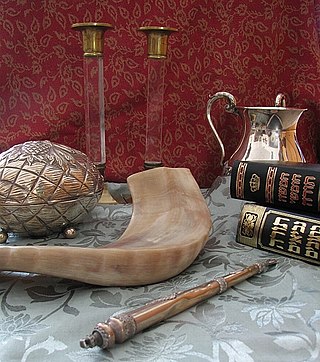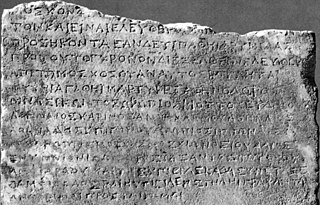
The brit milah or bris is the ceremony of circumcision in Judaism and Samaritanism, during which the foreskin is surgically removed. According to the Book of Genesis, God commanded the biblical patriarch Abraham to be circumcised, an act to be followed by his male descendants on the eighth day of life, symbolizing the covenant between God and the Jewish people. Today, it is generally performed by a mohel on the eighth day after the infant's birth and is followed by a celebratory meal known as seudat mitzvah.

Judaism is an Abrahamic monotheistic ethnic religion that comprises the collective spiritual, cultural, and legal traditions of the Jewish people. Religious Jews regard Judaism as their means of observing the Mosaic covenant, which was established between God and the Israelites, their ancestors. The religion is considered one of the earliest monotheistic religions in the world.

The Israelites were a Hebrew-speaking ethnoreligious group consisting of tribes that inhabited much of Canaan during the Iron Age.

Herod I or Herod the Great was a Roman Jewish client king of the Herodian Kingdom of Judea. He is known for his colossal building projects throughout Judea. Among these works are the rebuilding of the Second Temple in Jerusalem and the expansion of its base—the Western Wall being part of it. Vital details of his life are recorded in the works of the 1st century CE Roman–Jewish historian Josephus.
Olry Terquem was a French mathematician. He is known for his works in geometry and for founding two scientific journals, one of which was the first journal about the history of mathematics. He was also the pseudonymous author of a sequence of letters advocating radical reform in Judaism. He was French Jewish.
Religious circumcision is generally performed shortly after birth, during childhood, or around puberty as part of a rite of passage. Circumcision for religious reasons is most frequently practiced in Judaism and Islam.

The Holy Prepuce, or Holy Foreskin, is one of several relics attributed to Jesus, consisting of the foreskin removed during the circumcision of Jesus. At various points in history, a number of churches in Europe have claimed to possess the Prepuce, sometimes at the same time. Various miraculous powers have been ascribed to it.
A mohel is a Jewish man trained in the practice of brit milah, the "covenant of male circumcision". Women who are trained in the practice are referred to as a mohelet.
Circumcision likely has ancient roots among several ethnic groups in sub-equatorial Africa, Egypt, and Arabia, though the specific form and extent of circumcision has varied. Ritual male circumcision is known to have been practiced by South Sea Islanders, Aboriginal peoples of Australia, Sumatrans, and some Ancient Egyptians.

Most scholars who study the historical Jesus and early Christianity believe that the canonical gospels and the life of Jesus must be viewed within their historical and cultural context, rather than purely in terms of Christian orthodoxy. They look at Second Temple Judaism, the tensions, trends, and changes in the region under the influence of Hellenism and the Roman occupation, and the Jewish factions of the time, seeing Jesus as a Jew in this environment; and the written New Testament as arising from a period of oral gospel traditions after his death.
The Hebrew Bible makes reference to a number of covenants with God (YHWH). These include the Noahic Covenant set out in Genesis 9, which is decreed between God and all living creatures, as well as a number of more specific covenants with Abraham, the whole Israelite people, the Israelite priesthood, and the Davidic lineage of kings. In form and terminology, these covenants echo the kinds of treaty agreements existing in the surrounding ancient world.

Gideon Brecher, also known by the pen name Gedaliah ben Eliezer (Hebrew: גדליה בן אליעזר, was an Austrian writer and physician. He was a central figure in the Moravian Haskalah.
Early criticism of Judaism and its texts, laws, and practices originated in inter-faith polemics between Christianity and Judaism. Important disputations in the Middle Ages gave rise to widely publicized criticisms. Modern criticisms also reflect the inter-branch Jewish schisms between Orthodox Judaism, Conservative Judaism, and Reform Judaism.
Hellenistic Judaism was a form of Judaism in classical antiquity that combined Jewish religious tradition with elements of Hellenistic culture and religion. Until the early Muslim conquests of the eastern Mediterranean, the main centers of Hellenistic Judaism were Alexandria in Egypt and Antioch in Turkey, the two main Greek urban settlements of the Middle East and North Africa, both founded in the end of the 4th century BCE in the wake of the conquests of Alexander the Great. Hellenistic Judaism also existed in Jerusalem during the Second Temple Period, where there was a conflict between Hellenizers and traditionalists.
The Abrahamic religions are a grouping of three of the major religions together due to their historical coexistence and competition; it refers to Abraham, a figure mentioned in the Hebrew Bible, the Christian Bible, and the Quran respectively, and is used to show similarities between these religions and put them in contrast to Indian religions, Iranian religions, and the East Asian religions. Furthermore, some religions categorized as "Abrahamic" also share elements from other categories, such as Indian religions, or for example, Islam with Eastern religions.

The circumcision of Jesus is an event from the life of Jesus, according to the Gospel of Luke chapter 2, which states:
And when eight days were fulfilled to circumcise the child, his name was called Jesus, the name called by the angel before he was conceived in the womb.

Peter Charles Remondino was an Italian-American physician, pro-circumcision advocate, first president of the San Diego Board of Health, and co-founder of San Diego’s first private hospital. In the course of a medical career spanning 55 years, he served with the Union forces during the American Civil War as surgeon. He also served as a surgeon during the Franco-Prussian War, for which he was awarded a medal by the French Government for his services.
Second Temple Judaism is the Jewish religion as it developed during the Second Temple period, which began with the construction of the Second Temple around 516 BCE and ended with the Roman siege of Jerusalem in 70 CE.

Ioudaios is an Ancient Greek ethnonym used in classical and biblical literature which commonly translates to "Jew" or "Judean".
Abraham Leo Wolbarst was an American physician.









